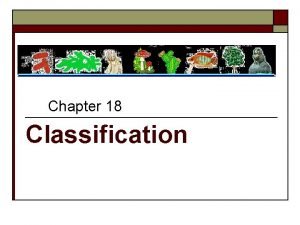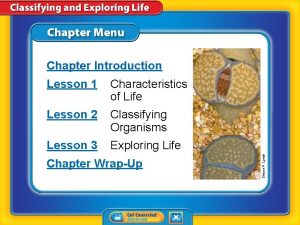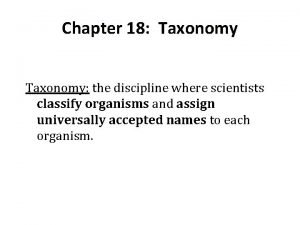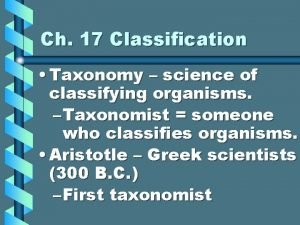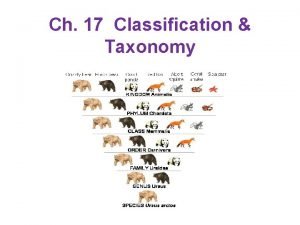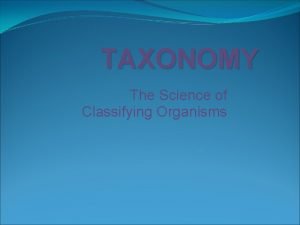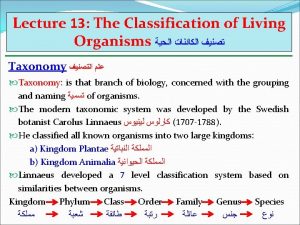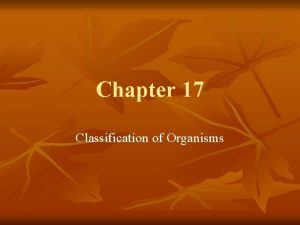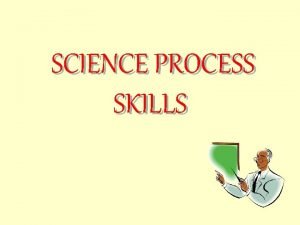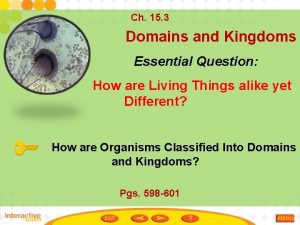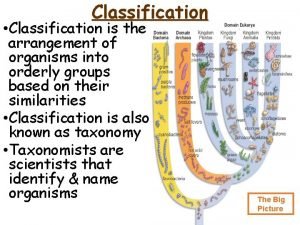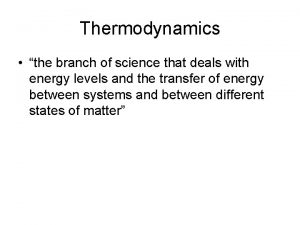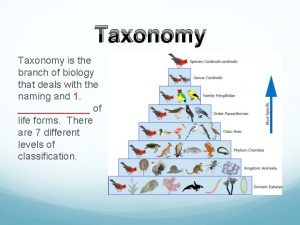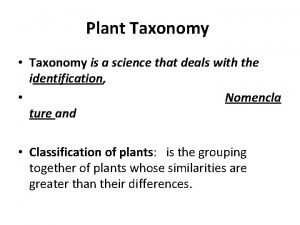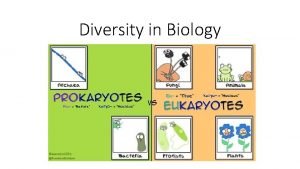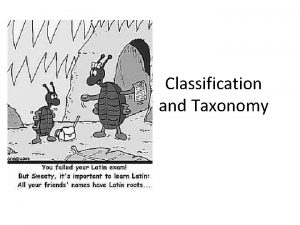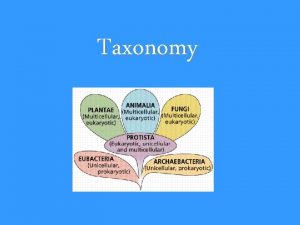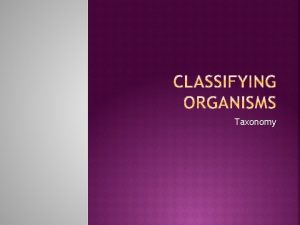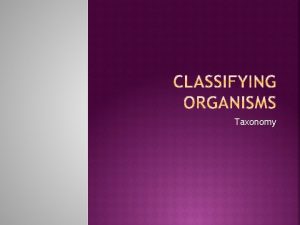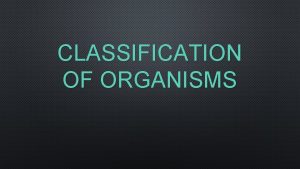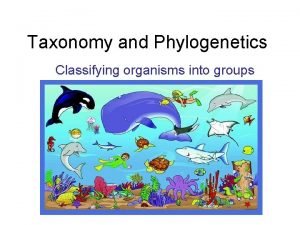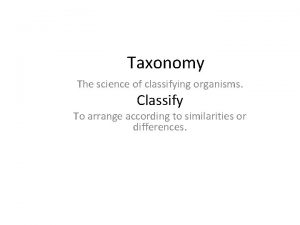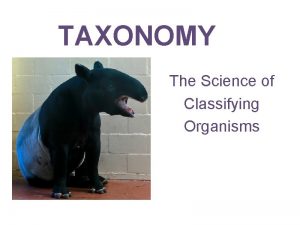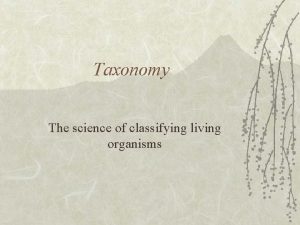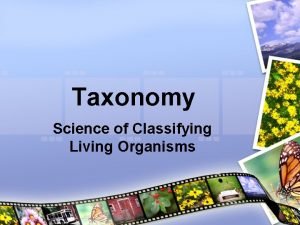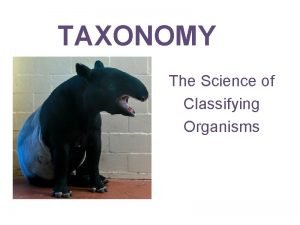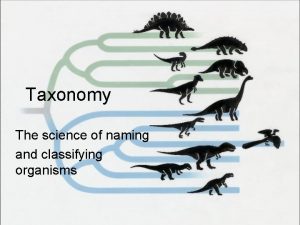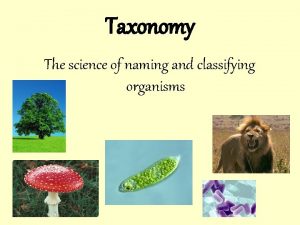Taxonomy Taxonomy the science of classifying organisms into














































- Slides: 46

Taxonomy

• Taxonomy- the science of classifying organisms into groups • Think of the classifications as a hypothesis. As new discoveries are made and new technologies are developed, sometimes the classifications change

Carolus Linnaeus • Swedish naturalist who laid the foundation for our modern classification system in the mid-1700 s including the use of binomial nomenclature

Linnaeus developed the scientific naming system still used today. • Taxonomy is the science of naming and classifying organisms. • A taxon is a group of organisms in a classification system. White oak: Quercus alba

Binomial nomenclature is a two-part scientific naming system. – uses Latin words – scientific names always written in italics – two parts are the genus name and species descriptor

Why Latin? • Latin is a dead language (it isn’t spoken natively anymore), so it isn’t changing • Most scholars at the time new Latin • Latin is a very descriptive language

• A genus includes one or more physically similar species – Species in the same genus are thought to be closely related. – Genus name is always capitalized. • A species descriptor is the second part of a scientific name. – always lowercase – always follows genus name; never written alone

Scientific names help scientists to communicate – Some species have very similar common names. – Some species have many common names.

Linnaeus’ classification system has seven levels. • Each level is included in the level above it. • Levels get increasingly specific from kingdom to species.

The Linnaean classification system has limitations. • Linnaeus taxonomy doesn’t account for molecular evidence. – The technology didn’t exist during Linneaus’ time. – Linnaean system based only on physical similarities.

Vocabulary Which term means one-celled? Many-celled? • multicellular • unicellular Which term means that the organism produces its own food? Consumes food? • autotroph • heterotroph

Vocabulary • Prokaryotic – describes an organism with cells that have a cell membrane but do NOT have a nuclear membrane • Eukaryotic – describes an organism with cells that have a cell membrane and a nuclear membrane

Vocabulary • Autotrophic – makes its own food • Heterotrophic – gets nutrients from the food it consumes

List of the Three Domains and the Six Kingdoms 1. Domain Bacteria • Kingdom Eubacteria 2. Domain Archaea • Kingdom Archaebacteria 3. Domain Eukarya • • Kingdom Protista Kingdom Fungi Kingdom Plantae Kingdom Animalia




http: //www. tellapallet. com/tre e_of_life. htm

Overview of the Three Domains and Six Kingdoms

Kingdom Eubacteria • Most abundant organisms on the Earth • Bacteria can live in many places on earth, inhabiting a wide variety of habitats, including other organisms • Unicellular • Prokaryotic • Autotrophic or heterotrophic • Thick cells walls with peptidoglycan

Kingdom Eubacteria • Bacteria come in different shapes, such as round, spiral and rodshaped.

Kingdom Eubacteria • Bacteria can cause a wide variety of diseases, such as strep throat, food poisoning and the Black Death (bubonic plague of the Middle Ages)


Kingdom Eubacteria • Bacteria also play an important role in decomposition, nitrogen fixation and human digestion (E. coli) Soybean root containing billions of bacteria

Kingdom Eubacteria • Procholorococcus – an autotrophic bacterium – What does that mean about how it gets its nutrients?

Kingdom Eubacteria • Bacteria from a Nitrifying Trickle Filter (NTF) stained with acridene orange. The stain makes DNA appear yellow and RNA appear orange.

Kingdom Archaebacteria • Bacteria that live in extreme habitats (extremophiles), such as hot springs, geysers, volcanic hot pools, brine pools, black smokers (hydrothermal vents) • Unicellular • Prokaryotic • Autotrophic or heterotrophic • Cell walls without peptidoglycan

Kingdom Archaebacteria Morning Glory Pool in Yellowstone National Park – note the bright colors from the archaebacteria growing in the extremely hot water.

Kingdom Archaebacteria • Bacillus infernus Some live in temperatures as high as 230° F

Kingdom Archaebacteria • Archaebacteria can live deep in the ocean near hydrothermal vents • There is no light, so they carry out chemosynthesis instead of photosynthesis

Kingdom Protista • Extremely diverse group • Eukaryotic • Most unicellular, some colonial, some multicellular • Autotrophic and heterotrophic • Some with cell walls containing cellulose; some carry out photosynthesis with chloroplasts

Kingdom Protista Euglena - autotrophic Volvox – a colonial protist A slime mold Amoeba - heterotrophic

Kingdom Fungi • Eukaryotic • Most are multicellular • Heterotrophic, decomposers- feed on dead or decaying organic matter, digest food externally and then absorb the nutrients • Cell walls made of chitin

Kingdom Fungi Stilton cheese Bread mold

Kingdom Plantae • • • Eukaryotic Multicellular Autotrophic Cell wall of cellulose; chloroplasts present True tissues

Kingdom Plantae

Kingdom Animalia • • • Eukaryotic Multicellular Heterotrophic No cell walls, no chloroplasts True tissues

Kingdom Animalia Flatworm Sponge Jellyfish Octopus Coral snake Bear

Some Animal Phylums Porifera- sponges Cnidaria- hydra, jellyfish, corals, sea anemones Platyhelminthes (flatworms)- planarians, flukes, tapeworms Nematoda (roundworms) Annelida (segmented worms)- earthworm Mollusca- bivalves (clams, oysters), gastropods (snails, slugs), cephalopods (squid, octopus) • Echinodermata- starfish, sea urchins, sea cucumbers • Arthropoda- crustacea, spiders, insects • Chordata- fish, amphibians, reptiles, birds, mammals • • •

Organ Systems • • Integumentary Skeletal Muscular Respiratory Digestive Circulatory Lymphatic • • Excretory Nervous Endocrine Reproductive

Symmetry • Symmetrical ~ animal can be cut into 2 equal halves. • Asymmetrical ~body patterns cannot be divided into equal halves. • Human Brain • AMOEBA



Anatomical Terms • • • Cephalic- concerning the head Caudal- concerning the tail Anterior- toward the front; forward Posterior- toward the rear; farther back Dorsal- on or near the upper surface; back Ventral- on or near the lower surface; front Lateral- on or toward the side Medial- on or toward the middle Midline (median)- divides into right and left Transverse- crosses perpendicular to midline p 446


At least 95% of the more than 1, 367, 000 species of animals are invertebrates.
 Kingdom animalia cladogram
Kingdom animalia cladogram Kingdom genus species family class order
Kingdom genus species family class order The science of naming and classifying organisms
The science of naming and classifying organisms Sunflower classification
Sunflower classification Classifying and exploring life lesson 2 answers
Classifying and exploring life lesson 2 answers Classifying organisms worksheet
Classifying organisms worksheet Lesson outline classifying organisms
Lesson outline classifying organisms Lesson 2 classifying organisms
Lesson 2 classifying organisms Fungi cell
Fungi cell Discipline of classifying and naming organisms
Discipline of classifying and naming organisms Why do scientists classify organisms?
Why do scientists classify organisms? Discipline of classifying and naming organisms
Discipline of classifying and naming organisms Classification groups in order
Classification groups in order Member of the same species
Member of the same species Unicellular and multicellular.
Unicellular and multicellular. Organisms taxonomy
Organisms taxonomy Binomial nomenclature consists of two names *
Binomial nomenclature consists of two names * This is the study of grouping and naming organisms
This is the study of grouping and naming organisms Organisms taxonomy
Organisms taxonomy Taxonomy in biology
Taxonomy in biology Kendall and marzano's new taxonomy
Kendall and marzano's new taxonomy Conversation about favorite subject
Conversation about favorite subject Basic scientific skills
Basic scientific skills Science process skills definition
Science process skills definition How are organisms classified into domains and kingdoms
How are organisms classified into domains and kingdoms Biological taxonomy
Biological taxonomy Biology kingdoms
Biology kingdoms Arrangement of organisms
Arrangement of organisms Thermodynamics is the branch of science that deals with
Thermodynamics is the branch of science that deals with Are coelenterates warm or cold blooded
Are coelenterates warm or cold blooded Taxonomy is a branch of science which
Taxonomy is a branch of science which Loculicidal capsule fruit
Loculicidal capsule fruit Taxonomy is the science that deals with
Taxonomy is the science that deals with Hát kết hợp bộ gõ cơ thể
Hát kết hợp bộ gõ cơ thể Bổ thể
Bổ thể Tỉ lệ cơ thể trẻ em
Tỉ lệ cơ thể trẻ em Chó sói
Chó sói Tư thế worm breton
Tư thế worm breton Chúa yêu trần thế alleluia
Chúa yêu trần thế alleluia Môn thể thao bắt đầu bằng từ đua
Môn thể thao bắt đầu bằng từ đua Thế nào là hệ số cao nhất
Thế nào là hệ số cao nhất Các châu lục và đại dương trên thế giới
Các châu lục và đại dương trên thế giới Công thức tính độ biến thiên đông lượng
Công thức tính độ biến thiên đông lượng Trời xanh đây là của chúng ta thể thơ
Trời xanh đây là của chúng ta thể thơ Mật thư anh em như thể tay chân
Mật thư anh em như thể tay chân 101012 bằng
101012 bằng
